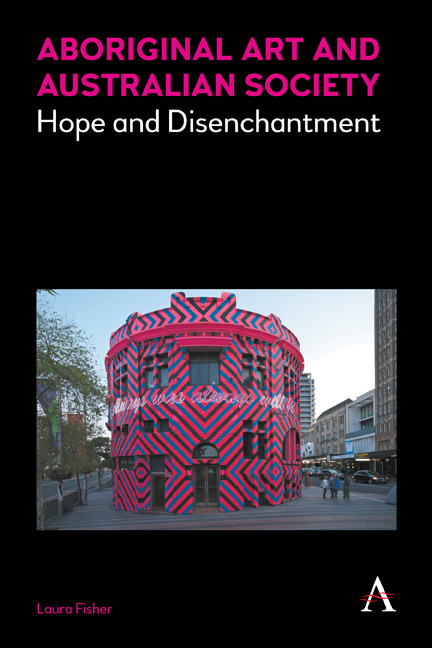Book contents
- Frontmatter
- Dedication
- Contents
- Preface and Acknowledgements
- Introduction
- Part I Governance, Nationhood and Civil Society
- Part II Contemporary Aboriginal Art in the 1980s
- Part III Negotiating Difference
- Chapter 7 Negotiating Aboriginal Difference
- Chapter 8 The Art/Anthropology Binary
- Part IV Aboriginal Art, Money and the Market
- Conclusion
- Notes
- References
- Index
Chapter 8 - The Art/Anthropology Binary
from Part III - Negotiating Difference
Published online by Cambridge University Press: 22 July 2017
- Frontmatter
- Dedication
- Contents
- Preface and Acknowledgements
- Introduction
- Part I Governance, Nationhood and Civil Society
- Part II Contemporary Aboriginal Art in the 1980s
- Part III Negotiating Difference
- Chapter 7 Negotiating Aboriginal Difference
- Chapter 8 The Art/Anthropology Binary
- Part IV Aboriginal Art, Money and the Market
- Conclusion
- Notes
- References
- Index
Summary
‘The story’ is of great importance to another group of people who are professionally engaged in the Aboriginal art arena: anthropologists. Anthropologists are keen to convey the content of Aboriginal art to art audiences for quite different reasons than entrepreneurial dealers, yet these reasons have been just as aggravating for many people in the contemporary art arena.
As noted previously, art and anthropology (or ethnography) are often situated as being hostile to one another in Aboriginal art discourses. This binary is frequently presented in narrative form, such that Aboriginal art is understood to have journeyed from anthropology or ethnography to art. For example, in 1976, in a much cited Art & Australia essay titled ‘Aboriginal Art as Art’, Australian art historian and former NGA curator of Australian art, Daniel Thomas, wrote that ‘Australian Aboriginal art became art, as far as the European-Australian art world was concerned, in the 1940s. Previously it had been anthropology’ (1976, 281). Here Thomas alludes to the moment when modern Australian artists such as Margaret Preston began to promote and appropriate the formal properties of Aboriginal cultural objects, and the first art gallery exhibitions of Aboriginal art took place at locations such as the David Jones Art Gallery in Sydney (Edwards 2005; Thomas 1999, 121–24; Morphy 2001; Stephen 2006). Thomas goes on to write that:
It was not until the 1950s, however, that the art museums of Australia began to form small collections of Aboriginal art, not in rivalry with the great collections that already existed in all the natural-history museums, but to give Aboriginal artists the dignity of an art-museum context, to make their large collections of Australian art more truly Australian and to give the art public, which might never visit a science museum, an opportunity to see work of great beauty. (281; see also 1988)
This view has been echoed many times in subsequent years, including by the current director of the National Gallery of Australia, Ron Radford, when he launched the gallery's dedicated wing for Indigenous art in 2010 (Hinkson 2010/2011; see also Neale 2014). For example curator Judith Ryan writes that ‘[t]he best Aboriginal works are no longer trapped in an ethnographic category but possess a unique aesthetic aura born of truth’ (2006, 10, see also 2010).
- Type
- Chapter
- Information
- Aboriginal Art and Australian SocietyHope and Disenchantment, pp. 117 - 132Publisher: Anthem PressPrint publication year: 2016



